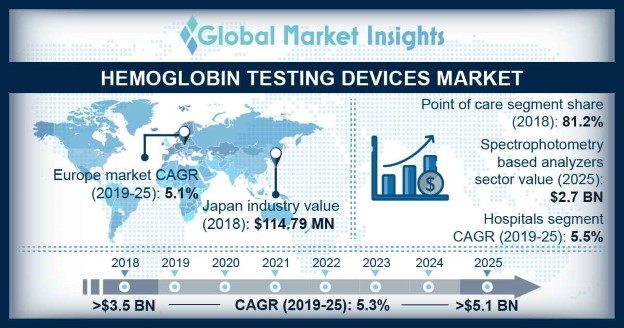Home > Healthcare > Medical Devices > Diagnostic Devices > Hemoglobin Testing Devices Market
Hemoglobin Testing Devices Market Size
- Report ID: GMI4415
- Published Date: Nov 2019
- Report Format: PDF
Hemoglobin Testing Devices Market Size
Hemoglobin Testing Devices Market size exceeded 3.5 billion in 2018 and is expected to register over 5.3% CAGR up to 2025.
Hemoglobin is an iron-based metalloprotein in the red blood cells of humans. Its key function is to transport oxygen from the lungs to the rest of the body. Hemoglobin test measures the level of hemoglobin or count the red blood cells (RBC) in blood. These tests are used extensively by physicians and doctors to diagnose any therapeutic conditions in the patient. If the results of the test depict a lower concentration of hemoglobin in the blood stream, it indicates higher chances of patients being anaemic. Rising prevalence of anaemia across the globe is a major factor augmenting hemoglobin testing devices industry growth.
| Report Attribute | Details |
|---|---|
| Base Year: | 2018 |
| Hemoglobin Testing Devices Market Size in 2018: | 3.5 Billion (USD) |
| Forecast Period: | 2019 to 2025 |
| Forecast Period 2019 to 2025 CAGR: | 5.3% |
| 2025 Value Projection: | 5 Billion (USD) |
| Historical Data for: | 2014 to 2018 |
| No. of Pages: | 160 |
| Tables, Charts & Figures: | 295 |
| Segments covered: | Product, Technology, End-use and Region |
| Growth Drivers: |
|
| Pitfalls & Challenges: |
|
The introduction of hemoglobin analyzers can be traced back to late 1950’s for diagnosis of blood related disorders. Initially, hemoglobin analyzers were incorporated with single histogram per module, that creates error while estimating the total cell count. Hence, to overcome such difficulties hemoglobin analyzers with novel VCSn (volume, conductivity, light scatter) technology were introduced. Such technological advancement is one of the major factors driving the industry. Hemoglobin testing devices market is fragmented in nature with various companies operating in the market. Moreover, introduction of point of care hemoglobin analyzers has further augmented business growth. For instance, in 1991 HemoCue Inc. introduced HemoCue analyzer; a point of care based hematology analyzer for diagnosis of anaemia. Hence, the aforementioned factors are contributing significantly to drive the industry growth.
Rising technological advancements in the hemoglobin analyzers to tackle common laboratory challenges
Rising technological advancements in hemoglobin testing analyzers is another major factor stimulating industry growth. The traditional hematology analyzers have a few limitations while differentiating cellular elements, due to presence of single histogram per module. However, modern analyzers are incorporated with novel technology to gauge data from multiple histograms, thereby overcoming the limitations of traditional analyzers. Hence, such technological advancements will improve the test outcome and boost product demand across the forecast years.
However, product recalls due to irregularities and inaccuracy of hemoglobin testing results will hamper market growth. Moreover, high cost associated with hemoglobin testing analyzers will further limit market growth.

